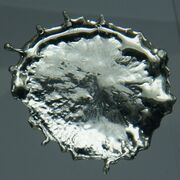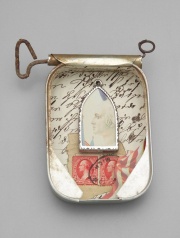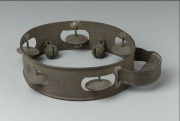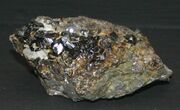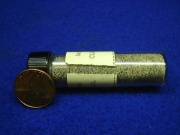Difference between revisions of "Tin"
(username removed) |
|||
| (19 intermediate revisions by 4 users not shown) | |||
| Line 1: | Line 1: | ||
| − | [[File:2006.142-SC177516.jpg|thumb| | + | [[File:Tin-2.jpg|thumb|Droplet of solidified tin metal<br>Credit:Jurii [https://commons.wikimedia.org/w/index.php?curid=6889757]]] |
| + | [[File:Inside of a tin platted can.jpg|thumb|Inside of can made from tin-plated steel<br>Credit: Schtone [https://commons.wikimedia.org/w/index.php?curid=5975363 ]]] | ||
| + | [[File:2006.142-SC177516.jpg|thumb|Tin can brooch<br>MFA Acc. #: 2006.142]] | ||
== Description == | == Description == | ||
| + | [[File:17.2173-SC24635.jpg|thumb|Pateruva<br>MFA Acc. #: 17.2173]] | ||
| + | A soft, white, ductile metallic element that occurs naturally as [[cassiterite]], a tin oxide mineral. Tin has an abundance of 6 ppm in the earth's crust and it discovery dates to approximately 35th c. BC. Currently, the | ||
| + | major producers are : China, Indonesia, Peru, Bolivia, Brazil, Congo (Kinshasa), Vietnam, Malaysia, Australia, and Russia. Tin was produced for centuries in Cornwall by the Romans. It was (and still is) used as an ingredient in [[bronze]] casting alloys. [[Pewter]] is a tin (90%) alloy with [[copper]] and [[antimony]]. Tin alloyed with lead (75-90%) is called leaded tin. Both pure tin (also called bright tin and [[tinplate]]) and leaded tin were used in the U.S. in the 18th century as [[iron]] coatings in architectural construction (roofing pans, flashings, gutters) and for decorative items (trays, utensils, kitchenware, candlesticks, and boxes). From the 19th century, tin was used for cast toys and as a plating for iron toys. Tin quickly forms a passive oxide layer that resists pollutants and corrosion. However, any breaks or pits in the tin layer can cause severe deterioration due to galvanic action between the tin and iron. | ||
| + | [[File:Cassiterite09.jpg|thumb|Cassiterite, main ore of tin<br>Credit: Reno Chris [https://commons.wikimedia.org/w/index.php?curid=1991160]]] | ||
| + | [[File:tinoreemr1.jpg|thumb|Tin ore]] | ||
| − | |||
| − | |||
| − | |||
== Synonyms and Related Terms == | == Synonyms and Related Terms == | ||
| − | Sn; stannum; | + | Sn; stannum; étain (Fr.); Zinn (Deut.); stagno (It.); estanho (Port.); estaño (Esp.); tin (Ned.); Tenn (Sven.); straits tin (from Malaysia); tin flake; tin metal; tole |
| − | + | == Risks == | |
| − | |||
| − | |||
| − | |||
| − | |||
| − | |||
| − | |||
| − | |||
| − | |||
| − | |||
| − | |||
| − | |||
| − | |||
| − | |||
| − | |||
| − | |||
| − | |||
| − | |||
| − | |||
| − | |||
| − | |||
| − | |||
| − | |||
| − | |||
| − | |||
| − | |||
| − | |||
| − | |||
| − | |||
| − | |||
| − | |||
| − | |||
| − | |||
| − | |||
| − | |||
| − | == | ||
| − | + | * Tin crumbles to dust at temperatures below 18 C (tin pest). | |
| − | + | * Inorganic tin compounds can cause skin irritation. | |
| − | == | + | * Organic tin compounds are toxic causing headaches, nausea, pain. |
| − | + | * ThermoFisher: [https://www.fishersci.com/msds?productName=AC223681000 SDS] | |
| − | * | + | == Physical and Chemical Properties == |
| + | * Composition = Sn (atomic no. 50; atomic wt = 118.710) | ||
| + | * CAS = 7440-31-5 | ||
| + | * Melting Point = 231.9 C | ||
| + | * Density = 7.2984 g/ml | ||
| + | * Mohs hardness = 1.5 | ||
| + | * Resistant to organic acids. Dissolves slowly in dilute hydrochloric and nitric acids. | ||
| + | * Insoluble in water. | ||
| + | * [[cacotheline|Cacotheline nitrate]] may be used for the colorimetric detection of tin in objects. Cacotheline reacts with tin to produce a dark purple residue. | ||
| + | == Resources and Citations == | ||
| + | * Wikipedia: [https://en.wikipedia.org/wiki/Tin Tin] Accessed August 2024 | ||
| + | * O. Untracht, ''Metal Techniques for Craftsmen'', Doubleday and Co., Garden City, NY, 1968. | ||
| + | * J.Waite, "Architectural Metals: Their Deterioration and Stabilization" in ''Preservation and Conservation: Principles and Practice'', S.Timmons (ed.), Preservation Press, Washington DC, 1976, p. 213. | ||
| + | * Web Elements: [http://www.webelements.com/webelements/elements/text/Sn/key.html Website] | ||
| + | * Ancient Trade Routes: [http://www.ancientroute.com/resource/metal/tin.htm Website] | ||
| + | * Richard S. Lewis, ''Hawley's Condensed Chemical Dictionary'', Van Nostrand Reinhold, New York, 10th ed., 1993 | ||
* ''The Merck Index'', Martha Windholz (ed.), Merck Research Labs, Rahway NJ, 10th edition, 1983 Comment: entry 9587 | * ''The Merck Index'', Martha Windholz (ed.), Merck Research Labs, Rahway NJ, 10th edition, 1983 Comment: entry 9587 | ||
| − | + | * G.S.Brady, ''Materials Handbook'', McGraw-Hill Book Co., New York, 1971 Comment: p. 809 | |
| − | * | ||
| − | |||
* ''Dictionary of Building Preservation'', Ward Bucher, ed., John Wiley & Sons, Inc., New York City, 1996 | * ''Dictionary of Building Preservation'', Ward Bucher, ed., John Wiley & Sons, Inc., New York City, 1996 | ||
| − | |||
* ''Encyclopedia of Archaeology'', Glyn E. Daniel, ed., Thomas Y. Crowell Co., New York, 1977 | * ''Encyclopedia of Archaeology'', Glyn E. Daniel, ed., Thomas Y. Crowell Co., New York, 1977 | ||
| − | + | * David C. Scott, ''Metallography and Microstructure of Ancient and Historic Metals'', The Getty Conservation Institute, Los Angeles, 1991 | |
| − | * | + | * Tom Rowland, Noel Riley, ''A-Z Guide to Cleaning, Conserving and Repairing Antiques'', Constable and Co., Ltd., London, 1981 |
| − | + | * Jack Odgen, ''Jewellery of the Ancient World'', Rizzoli International Publications Inc., New York City, 1982 | |
| − | * | + | * A.Lucas, J.R.Harris, ''Ancient Egyptian Materials and Industries'', Edward Arnold Publishers Ltd., London, 4th edition, 1962 |
| − | |||
| − | * | ||
| − | |||
| − | * | ||
[[Category:Materials database]] | [[Category:Materials database]] | ||
Latest revision as of 11:58, 15 March 2025
Description
A soft, white, ductile metallic element that occurs naturally as Cassiterite, a tin oxide mineral. Tin has an abundance of 6 ppm in the earth's crust and it discovery dates to approximately 35th c. BC. Currently, the major producers are : China, Indonesia, Peru, Bolivia, Brazil, Congo (Kinshasa), Vietnam, Malaysia, Australia, and Russia. Tin was produced for centuries in Cornwall by the Romans. It was (and still is) used as an ingredient in Bronze casting alloys. Pewter is a tin (90%) alloy with Copper and Antimony. Tin alloyed with lead (75-90%) is called leaded tin. Both pure tin (also called bright tin and Tinplate) and leaded tin were used in the U.S. in the 18th century as Iron coatings in architectural construction (roofing pans, flashings, gutters) and for decorative items (trays, utensils, kitchenware, candlesticks, and boxes). From the 19th century, tin was used for cast toys and as a plating for iron toys. Tin quickly forms a passive oxide layer that resists pollutants and corrosion. However, any breaks or pits in the tin layer can cause severe deterioration due to galvanic action between the tin and iron.
Synonyms and Related Terms
Sn; stannum; étain (Fr.); Zinn (Deut.); stagno (It.); estanho (Port.); estaño (Esp.); tin (Ned.); Tenn (Sven.); straits tin (from Malaysia); tin flake; tin metal; tole
Risks
- Tin crumbles to dust at temperatures below 18 C (tin pest).
- Inorganic tin compounds can cause skin irritation.
- Organic tin compounds are toxic causing headaches, nausea, pain.
- ThermoFisher: SDS
Physical and Chemical Properties
- Composition = Sn (atomic no. 50; atomic wt = 118.710)
- CAS = 7440-31-5
- Melting Point = 231.9 C
- Density = 7.2984 g/ml
- Mohs hardness = 1.5
- Resistant to organic acids. Dissolves slowly in dilute hydrochloric and nitric acids.
- Insoluble in water.
- Cacotheline nitrate may be used for the colorimetric detection of tin in objects. Cacotheline reacts with tin to produce a dark purple residue.
Resources and Citations
- Wikipedia: Tin Accessed August 2024
- O. Untracht, Metal Techniques for Craftsmen, Doubleday and Co., Garden City, NY, 1968.
- J.Waite, "Architectural Metals: Their Deterioration and Stabilization" in Preservation and Conservation: Principles and Practice, S.Timmons (ed.), Preservation Press, Washington DC, 1976, p. 213.
- Web Elements: Website
- Ancient Trade Routes: Website
- Richard S. Lewis, Hawley's Condensed Chemical Dictionary, Van Nostrand Reinhold, New York, 10th ed., 1993
- The Merck Index, Martha Windholz (ed.), Merck Research Labs, Rahway NJ, 10th edition, 1983 Comment: entry 9587
- G.S.Brady, Materials Handbook, McGraw-Hill Book Co., New York, 1971 Comment: p. 809
- Dictionary of Building Preservation, Ward Bucher, ed., John Wiley & Sons, Inc., New York City, 1996
- Encyclopedia of Archaeology, Glyn E. Daniel, ed., Thomas Y. Crowell Co., New York, 1977
- David C. Scott, Metallography and Microstructure of Ancient and Historic Metals, The Getty Conservation Institute, Los Angeles, 1991
- Tom Rowland, Noel Riley, A-Z Guide to Cleaning, Conserving and Repairing Antiques, Constable and Co., Ltd., London, 1981
- Jack Odgen, Jewellery of the Ancient World, Rizzoli International Publications Inc., New York City, 1982
- A.Lucas, J.R.Harris, Ancient Egyptian Materials and Industries, Edward Arnold Publishers Ltd., London, 4th edition, 1962
